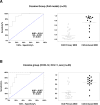Inflammatory mediators and dual depression: Potential biomarkers in plasma of primary and substance-induced major depression in cocaine and alcohol use disorders
- PMID: 30870525
- PMCID: PMC6417778
- DOI: 10.1371/journal.pone.0213791
Inflammatory mediators and dual depression: Potential biomarkers in plasma of primary and substance-induced major depression in cocaine and alcohol use disorders
Abstract
Major depressive disorder (MDD) is the most prevalent comorbid mental disorder among people with substance use disorders. The MDD can be both primary and substance-induced and its accurate diagnosis represents a challenge for clinical practice and treatment response. Recent studies reported alterations in the circulating expression of inflammatory mediators in patients with psychiatric disorders, including those related to substance use. The aim of the study was to explore TNF-α, IL-1β, CXCL12, CCL2, CCL11 (eotaxin-1) and CX3CL1 (fractalkine) as potential biomarkers to identify comorbid MDD and to distinguish primary MDD from substance-induced MDD in patients with substance disorders. Patients diagnosed with cocaine (CUD, n = 64) or alcohol (AUD, n = 65) use disorders with/without MDD were recruited from outpatient treatment programs [CUD/non-MDD (n = 31); CUD/primary MDD (n = 18); CUD/cocaine-induced MDD (N = 15); AUD/non-MDD (n = 27); AUD/primary MDD (n = 16) and AUD/alcohol-induced MDD (n = 22)]. Sixty-two healthy subjects were also recruited as control group. Substance and mental disorders were assessed according to "Diagnostic and Statistical Manual of Mental Disorders, 4th edition, text revision" (DSM-IV-TR) and a blood sample was collected for determinations in the plasma. The cocaine group showed lower TNF-α (p<0.05) and CCL11 (p<0.05), and higher IL-1β (p<0.01) concentrations than the control group. In contrast, the alcohol group showed higher IL-1β (p<0.01) and lower CXCL12 (p<0.01) concentrations than the control group. Regarding MDD, we only observed alterations in the cocaine group. Thus, CUD/MDD patients showed lower IL-1β (p<0.05), CXCL12 (p<0.05) and CCL11 (p<0.05), and higher CXC3CL1 (p<0.05) concentrations than CUD/non-MDD patients. Moreover, while CUD/primary MDD patients showed higher CCL11 (p<0.01) concentrations than both CUD/non-MDD and CUD/cocaine-induced MDD patients, CUD/cocaine-induced MDD patients showed lower CXCL12 (p<0.05) concentrations than CUD/non-MDD patients. Finally, a logistic regression model in the cocaine group identified CXCL12, CCL11 and sex to distinguish primary MDD from cocaine-induced MDD providing a high discriminatory power. The present data suggest an association between changes in inflammatory mediators and the diagnosis of primary and substance-induced MDD, namely in CUD patients.
Conflict of interest statement
The authors have declared that no competing interests exist.
Figures

References
-
- Samet S, Fenton MC, Nunes E, Greenstein E, Aharonovich E, Hasin D. Effects of independent and substance-induced major depressive disorder on remission and relapse of alcohol, cocaine and heroin dependence. Addiction. 2013;108(1):115–23. Epub 2012/07/11. 10.1111/j.1360-0443.2012.04010.x - DOI - PMC - PubMed
-
- APA. DSM-IV-TR: Diagnostic and statistical manual of mental disorders, text revision Washington, DC: American Psychiatric Association; 2000;75:78–85.
-
- APA. Diagnostic and statistical manual of mental disorders (DSM-5®): American Psychiatric Association; 2013. - PubMed
Publication types
MeSH terms
Substances
LinkOut - more resources
Full Text Sources
Medical
Research Materials
Miscellaneous

